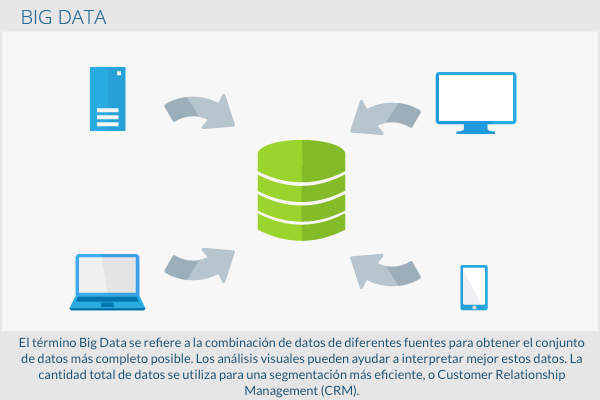The term Big data refers to combining data from different sources to achieve the most complete viable data set. Visual analysis can help you better interpret this data. The total amount of data is used for more efficient segmentation, or Customer Relationship Management (CRM). The overall goal of collecting big data is to increase conversions or sales. Databases referred to as big data require storage capacities that can no longer be measured in gigabytes. However, there is no set limit that determines when big data begins to be called.
Development
With the rapid development of storage media, there are even more ways to go through and benefit from large amounts of data. At the same time, the amount of data globally has increased as well. The volume of data is projected to double every two years globally. The reason for this is the increasing digitization of the world. Whereas years ago the databases were maintained or added manually, today very fast computers are handled. Whether it's shopping at the supermarket, booking a trip, ordering food at a restaurant or managing your health insurance details, each and every step is recorded, managed and organized by computers.
Big data is, in this way, the consequence of a general tendency of humanity to produce ever-increasing volumes of data. Today, big data is used in both science and business.

Technical requirements
Processing large amounts of data requires many steps. But big data can no longer be efficiently processed with conventional technology because it presupposes that the software can handle the following:
- Process multiple records at the same time.
- Import large amounts of data quickly.
- Make databases available quickly.
- Handle various queries to the database at the same time.
There are payment programs that meet these conditions, such as NeuroBayes, or also the software Hadoop.
Big data - Fields of application
Large companies especially see significant advantages with big data over their competitors, who have less data available. At the same time, you can save a lot of money when you have the ability to control entire business processes based on machine-readable data. But even in the realm of science, absolutely new assessment approaches that need to be tested on a statistical basis are only possible with the help of big data.
In practice, the following apps are conceived:
- Automated and fast market research that can respond immediately to changes.
- Discover fraud in financial transactions.
- Comprehensive web analytics to increase and make the most of online marketing campaigns.
- Comprehensive medical diagnosis.
- Control of energy consumption, for example, in a smart grid.
- Expanding the possibilities in e-commerce through flexible up-selling or cross-selling
- Profiling for intelligence or police services.
Critical handling of large volumes of data
Big data is considered an important component in online marketing. Large brands especially can work with larger data sets, which provides more marketing potential. However, big data, similar to segmentation, is often criticized because very precise user profiles can be created with large amounts of data. This makes big data a major invasion of user privacy. Companies that deal with large data must inform their customers or visitors, as part of the privacy policy, that user data is processed afterwards.
Companies like Google or other search engine providers that are financed through trade promotion have been working with big data obtained from user data and other available sources for years. Regular discussions about privacy usually focus on the problematic field of big data, since it presents individual companies with too much data. But even with other users of large data, there is a greater risk that the data will be misused and that this abuse will harm citizens in the long term.
Another criticism of big data is that they can only be analyzed based on algorithms due to the immense amount of data and thus have a very technical orientation. However, the IT industry is still at the beginning of handling large amounts of data, so more accurate evaluation methods can be expected in the future.
SEO benefits
If you consider the alternatives offered by web analysis tools such as Google Analytics, it is obvious that SEOs will also benefit from big data. By comparing benchmarks, keyword tools, etc., search engine optimizers get partial results from huge data sets that are clearly presented to use to get the most out of your projects. Large companies can also get important information for SEO and targeting strategies by merging their databases.



